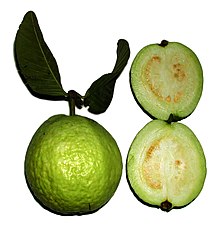Nutritional value
- Guavas are rich in dietary fiber, vitamins A and C, folic acid, and the dietary minerals, potassium, copper and manganese.
- Having a generally broad, low-calorie profile of essential nutrients, a single common guava (P. guajava) fruit contains about four times the amount of vitamin C as an orange.
However, nutrient content varies across guava cultivars. Although the strawberry guava (P. littorale var. cattleianum) has about 25% of the amount found in more common varieties, its total vitamin C content in one serving (90 mg) still provides 100% of the Dietary Reference Intake for adult males.
- Guavas contain both carotenoids and polyphenols like (+)-gallocatechin, guaijaverin, leucocyanidin and amritoside–the major classes of antioxidant pigments – giving them relatively high potential antioxidant value among plant foods] As these pigments produce the fruit skin and flesh color, guavas that are red-orange have more pigment content as polyphenol, carotenoid and pro-vitamin A, retinoid sources than yellow-green ones.
| |
Potential medical uses
- Guava leaves are used in folk medicine as a remedy for diarrhea and, as well as the bark, for their supposed antimicrobial properties and as an astringent.
- Guava leaves or bark are used in traditional treatments against diabetes
- .In Trinidad, a tea made from young leaves is used for diarrhea, dysentery and fever.Since the 1950s, guavas – particularly the leaves – have been the subject for diverse research on their constituents, pharmacological properties and history in folk medicine.Most research, however, has been conducted on apple guava (P. guajava), with other species remaining unstudied.
- From preliminary medical research in laboratory models,extracts from apple guava leaves or bark are implicated in therapeutic mechanisms gainst cancer, bacterial infections, inflammation and pain.
- Essential oils from guava leaves display anti-cancer activity in vitro
| Nutritional value per 100 g (3.5 oz) | |
|---|---|
| Energy | 285 kJ (68 kcal) |
| Carbohydrates | 14.32 g |
| - Sugars | 8.92 g |
| - Dietary fiber | 5.4 g |
| Fat | 0.95 g |
| Protein | 2.55 g |
| Vitamin A equiv. | 31 μg (4%) |
| - beta-carotene | 374 μg (3%) |
| Thiamine (vit. B1) | 0.067 mg (6%) |
| Riboflavin (vit. B2) | 0.04 mg (3%) |
| Niacin (vit. B3) | 1.084 mg (7%) |
| Pantothenic acid (B5) | 0.451 mg (9%) |
| Vitamin B6 | 0.11 mg (8%) |
| Folate (vit. B9) | 49 μg (12%) |
| Choline | 7.6 mg (2%) |
| Vitamin C | 228.3 mg (275%) |
| Vitamin K | 2.2 μg (2%) |
| Calcium | 18 mg (2%) |
| Iron | 0.26 mg (2%) |
| Magnesium | 22 mg (6%) |
| Manganese | 0.15 mg (7%) |
| Phosphorus | 40 mg (6%) |
| Potassium | 417 mg (9%) |
| Sodium | 2 mg (0%) |
| Zinc | 0.23 mg (2%) |
| Lycopene | 5204 µg |
| Link to USDA Database entry Percentages are roughly approximated using US recommendations for adults. Source: USDA Nutrient Database | |
References: http://en.wikipedia.org/wiki/Guava



No comments:
Post a Comment